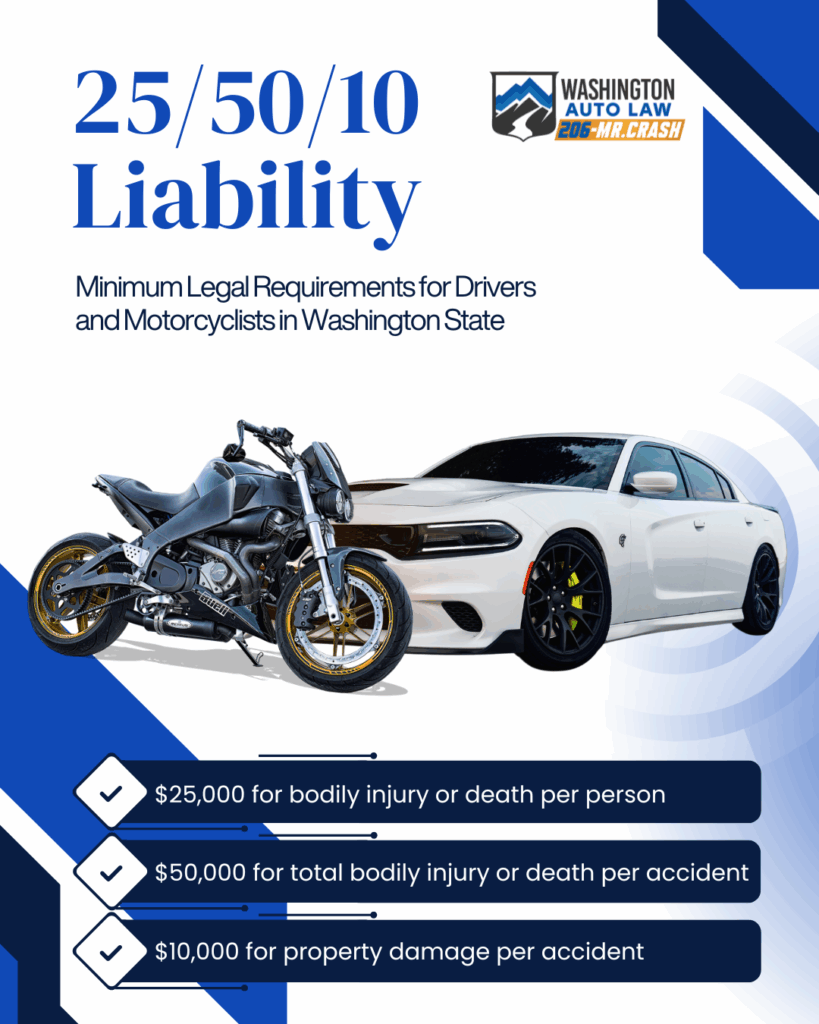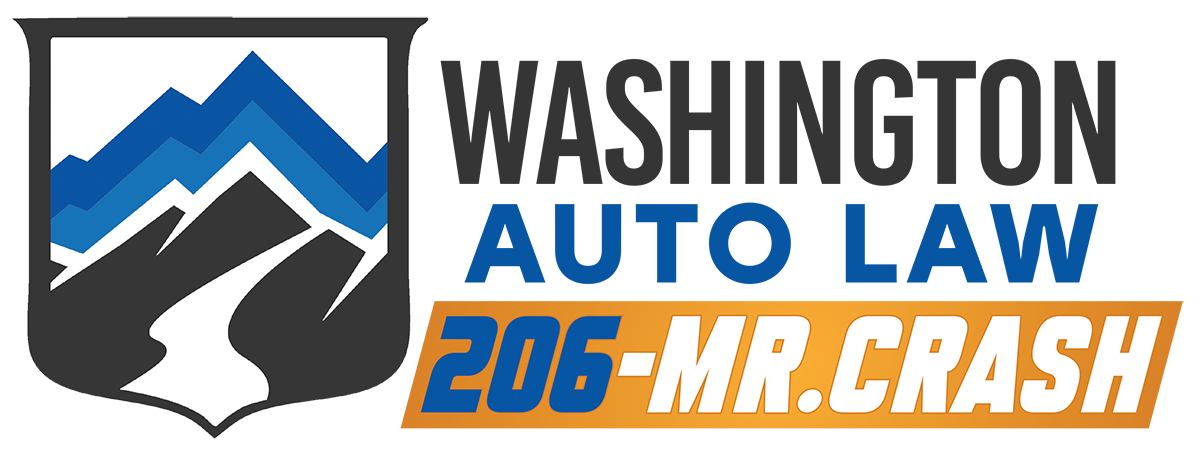Table of Contents
- Understanding 25/50/10: The Legal Minimum for Liability
- Why the Minimum Might Not Be Enough
- Coverage That Protects You: Optional But Essential Add-ons
- Legal Penalties for Riding Without Insurance
- How to Check and Update Your Coverage
- Why Proper Coverage Matters After a Motorcycle Accident
- Final Thoughts: Get the Coverage You Deserve Before You Ride
When you’re straddling the seat of your motorcycle, ready to hit Washington’s open roads, the last thing on your mind is the fine print in your insurance policy. But when something goes wrong, whether it’s another driver cutting you off or sliding on a slick road, you’ll be glad you understood your coverage.
Washington’s 25/50/10 liability coverage is the legal minimum required to operate a motorcycle, but what does that actually mean for you, your bike, and your finances? In this post, we break down this legal requirement in simple terms, explain why it often isn’t enough, and help you decide how to protect yourself better.
Understanding 25/50/10: The Legal Minimum for Liability
In July 2019, Washington State began requiring motorcyclists to carry insurance, just like car drivers. The baseline policy is often referred to as 25/50/10 liability coverage. But those numbers aren’t just random. They represent dollar limits your insurance company agrees to pay if you’re found at fault in a crash.
Breaking Down the Numbers
Here’s what each part means:
- $25,000 for bodily injury or death per person – This is the maximum amount your policy will pay to any single person injured in an accident you caused.
- $50,000 for total bodily injury or death per accident – This is the combined total for all people injured in the accident.
- $10,000 for property damage per accident – This pays for the damage you cause to someone else’s property (typically their vehicle).
So, if you cause a crash that injures two people and damages a car, your insurance company will pay up to $25,000 for each person’s medical bills (but no more than $50,000 total), and up to $10,000 to repair or replace the other person’s car.

Why the Minimum Might Not Be Enough
While 25/50/10 coverage satisfies Washington’s legal requirement, it may not go far enough, especially if the crash involves serious injuries or expensive vehicles.
Real-World Scenarios That Exceed Minimum Limits
Consider these situations:
- You rear-end a luxury SUV worth $70,000. Your insurance will only cover $10,000 in property damage. That means you could be on the hook for the remaining $60,000.
- You cause a multi-vehicle pileup with three injured people. Your policy caps at $50,000 total for bodily injury, which may not come close to covering ER visits, surgeries, rehab, and lost wages.
Medical costs in Washington can quickly exceed these limits. According to the Washington Health Alliance, the average emergency room visit alone typically costs $1,196, with total charges ranging from $898 to $1,626, and this does not include ambulance fees, imaging, or follow-up care.
What Happens When Costs Go Beyond Your Coverage?
When damages exceed your policy limits:
- You’re personally responsible for paying the difference.
- Victims may sue you, putting your savings, home, and income at risk.
- You could face wage garnishment or court judgments for years.
Liability insurance protects others from you. But who protects you when you’re the one who’s injured?
Coverage That Protects You: Optional But Essential Add-ons
While 25/50/10 liability is mandatory, it does nothing to cover your medical bills, bike repairs, or time off work if another driver is at fault—or worse, if they don’t have enough insurance.
To truly protect yourself, consider these critical coverage options:
1. Uninsured/Underinsured Motorist Coverage (UM/UIM)
- Pays when the other driver has no insurance or not enough to cover your losses.
- Especially important for motorcyclists, who are often seriously injured in crashes caused by distracted or careless drivers.
- Washington allows you to decline this coverage in writing, but doing so puts you at risk.
2. Personal Injury Protection (PIP)
- Covers medical expenses, lost wages, and funeral costs, regardless of fault.
- All motorcycle insurers in Washington may not offer PIP, but when available, it can be a financial lifesaver.
- Can help cover deductibles or expenses that health insurance won’t.
3. Comprehensive and Collision Coverage
- Covers your motorcycle if it’s damaged in a crash, stolen, or vandalized.
- Often required if you’re financing or leasing your bike.
- Helps repair or replace your bike without paying out of pocket.
Legal Penalties for Riding Without Insurance
Failing to carry at least 25/50/10 liability coverage can have serious consequences in Washington:
- Fines starting at $550
- License suspension
- Increased insurance premiums once you do get coverage
- Difficulty seeking damages if you’re injured and don’t have your own protection
Washington State Patrol and local police can ask for proof of insurance during any traffic stop. Don’t get caught unprepared.
How to Check and Update Your Coverage
If you’re not sure what your current policy includes, here are some simple steps to take:
- Review your declarations page—this is the summary of coverages, limits, and premiums.
- Call your insurance agent and ask for a clear explanation of what each number means.
- Ask specifically about: UM/UIM limits, PIP availability, and Deductibles on collision and comprehensive coverage
- If your insurer doesn’t offer motorcycle PIP, consider standalone medical coverage or increasing your health insurance protections.
And if you’re comparing policies, don’t just focus on the monthly premium—look at what protection you’re actually getting.
Why Proper Coverage Matters After a Motorcycle Accident
Motorcycle accidents frequently result in severe injuries, prolonged recovery periods, and significant medical expenses. Multiple studies highlight just how dangerous these crashes can be:
- Insurance Institute for Highway Safety (IIHS): Per mile traveled in the U.S., motorcyclists are nearly 29 times more likely to die in a crash than occupants of passenger vehicles.
- National Safety Council (NSC): Although motorcycles represent just 3% of all registered vehicles and 0.7% of total vehicle miles traveled, motorcyclists accounted for 14.6% of all traffic fatalities and 3.5% of all injuries in 2022.
- National Highway Traffic Safety Administration (NHTSA): In 2023, 6,335 motorcyclists and passengers were killed in traffic crashes—making motorcycles one of the most dangerous modes of transportation.
The financial consequences of a crash can be equally devastating:
- The average hospital bill after a motorcycle accident exceeds $15,000.
- Many injured riders are unable to work for weeks or even months, resulting in substantial lost income.
- If the at-fault driver is uninsured or underinsured, and you haven’t elected uninsured/underinsured motorist coverage (UM/UIM), you may have no viable path to recover your losses.
Final Thoughts: Get the Coverage You Deserve Before You Ride
Motorcycling in Washington is exhilarating, but it also carries unique risks, and unfortunately, many riders don’t realize how exposed they are until it’s too late. Washington’s 25/50/10 liability coverage may meet the state’s legal threshold, but it’s far from sufficient if you’re seriously injured or cause a high-cost accident.
Here’s what you should do now:
- Confirm you have at least 25/50/10 liability coverage (it’s required by law).
- Strongly consider adding UM/UIM, PIP, and comprehensive/collision coverage.
- Review your policy annually and update it when your circumstances change (new bike, new job, family needs).
And if you’ve already been injured in a motorcycle accident—especially one involving an underinsured driver or complex liability issues—you don’t have to figure it out alone.
Contact Washington Auto Law today for a free consultation. We’re here to help you understand your rights, work with insurance companies, and fight for the compensation you deserve. Call us at 206-497-4357 or schedule a no-pressure consultation now.
